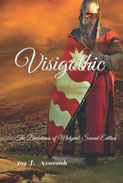
 |
Told by the skald Lothar, this is the story of the fight between good and evil in the heavens and the realms of man and beasts that include humans, elves, dwarves, dragons, and more. After giving some history and lineage, Lothar begins telling of the barbarian tribes of Midgard, specifically those of the shield maiden Gwynnalyn and her warrior husband, Sigurd, King of the Getic Tribe. After many years of toil under evil rulers, Sigurd and his tribe make plans to fight against the tyrants. They know they need two things specifically: iron weapons and collaboration among the other tribes. As their early attempts are successful, the true nature of the tyrants becomes known. They are led by a powerful wizard named Hister who has enlisted troops of goblins, ogres, gargoyles, and dragons. Hister seeks to create a giant magical weapon, a tower of Babel, and an all-seeing eye to conquer the lands in the name of his god, Loki, also known as Lucifer. As these true threats are revealed, the tribes will need to garner support from dwarves, elves, famed wizards, and even angels.
This is the first entry in an epic saga by the author. From what Newcomb shares in this beginning volume, it appears to be matching Robert Jordan’s Wheel of Time series in scope. The influences on the author and those who appear in the story are wide and varied. There are references from turning a child to the dark side to the enemies chanting “Hail Hister” to stylistic choices linked to old English epics and medieval literature. However, two influences tower above the others. The first is the Bible. Not only are there direct references to biblical characters, but the author occasionally presents information in a faux scripture format and writes a character lineage in the first part of this book that resembles the first books of the Old Testament. Additionally, the guidance of J.R.R. Tolkien is evident throughout. Many of the races and their behaviors are similar to Tolkien’s interpretation, and there are also winks to Gollum and the Eye of Sauron. Concerning style, Newcomb’s writing seems more in the vein of The Silmarillion than The Lord of the Rings.
Newcomb's saga is clearly aimed at fantasy readers looking for an epic struggle taking decades and involving many moving parts. The number of characters will be enormous, and the action will take place in multiple places and involve the histories of those involved as well as the present circumstances. Newcomb’s writing style is also reminiscent of the high-fantasy, English literature style of Tolkien. There are several grammatical errors in the text, but they don’t generally detract from the reading. The spiraling narrative and the inclusion of so many influences rather than a tighter narrative may be distracting to some. However, the book has appeal on multiple levels. It is devoid of graphic sex and profanity, and most of the battles do not become too gory. It emulates stories many fantasy readers have grown up reading. Finally, it will appeal to those fantasy readers who love long epic stories with huge volumes to read.